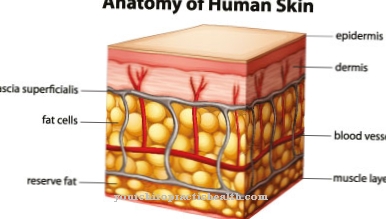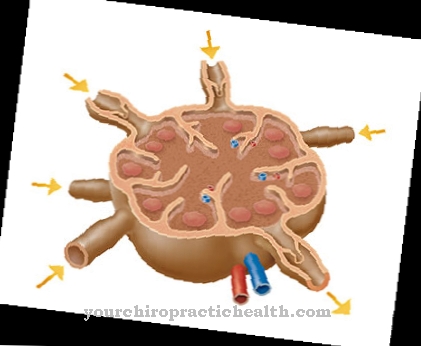From ambivalence is used in psychology with contrary emotions, thoughts or wishes. Bleuler sees ambivalence as the cause of diseases such as schizophrenia. An increase in the tolerance for ambivalence could thus prevent mental illnesses.
What is ambivalence?

Everyone is probably familiar with both-and-also attitudes such as love-hate relationships. Opposing evaluations in the form of thoughts or feelings are combined in such attitudes. These attitudes are described in psychology under certain conditions with the concept of ambivalence.
Accordingly, ambivalence is a psychological function. All things always have two sides. The psychological concept of ambivalence does not refer exclusively to this multi-sidedness, but above all to the resulting internal conflict. For a person with ambivalence, the contradiction of two points of view gives rise to opposing reaction options, which have an inhibiting effect on the ability to make decisions.
Karl Abraham describes children as typically ambivalent because they are driven by instinctual fluctuations. For the adult he assumes a freedom from ambivalence. According to him, mentally healthy adults do not experience ambivalence. Some psychoanalysts disagree with this view and see ambivalence in most of all human emotions.
The term psychological ambivalence goes back to Eugen Bleuler, who first used it at the beginning of the 20th century. Synonymous terms are those of ambition and ambiguity. Freud adopted the ambivalence in his psychoanalysis, developed it further and transferred it above all to social psychology.
causes
Bleuler sees the cause of psychological ambivalence in a drive control that is characteristic of children. In adults, he considers the ambivalence to be pathological and caused by a mental illness. As the causal connection of the ambivalence, he indicates the larger framework of schizophrenia.
Bleuler describes the simultaneous existence of contrary feelings and thoughts in the sense of ambivalence as the triggering moment of schizophrenia. For him, ambivalent opposing feelings are affective ambivalences. He describes ambivalent needs as ambitious tendencies and intellectual ambivalence for him is the juxtaposition of opposing thoughts, which causes conflicts in the patient and ultimately leads to a split in personality.
Schizophrenic tendencies and ambivalence are mutually dependent. These statements contradict the theories of many other sources. Numerous psychoanalysts recognize the ambivalence as typically human and do not necessarily regard it as a pathological phenomenon. Accordingly, you do not speak of an illness as the cause, but attribute the phenomenon to physiological processes in the human mind, body or spirit.
Many of them speak of an ambivalence between the libido and thanatos, which characterizes a large part of human impulses. Libido and Thanatos mean the simultaneous presence of love and drive to destruction.
You can find your medication here
➔ Medicines to calm down and strengthen nervesSymptoms, ailments & signs
Ultimately, a person with ambivalence behaves in a contradictory or disagreeable manner and thus does not work in harmony with himself. This contradictory behavior is basically not unusual for people. However, strong ambivalence can turn into a psychological impairment through certain situations, which results in imbalances in the psyche that require therapy.
Inconsistencies and inconsistencies in one's own behavior are therefore widespread to a certain extent, but according to Bleuler they can certainly cause mental illnesses as soon as they get out of hand. The simultaneous existence of contrary feelings, impulses or ideas of will does not necessarily have to express itself in phenomena such as love-hatefulness, but can also manifest itself in a life between obedience and rebellion.
There is often ambivalence, especially in the emotional behavior towards certain people. Freud describes the extreme case of ambivalence, for example, as an Oedipus complex. For two different people, the ambivalence tolerance is at different levels, i.e. the ability to tolerate ambivalence.
The more ambivalence-tolerant a person is, the more positively adjusted they appear in their personality and the better they can deal with natural human ambivalences. For people with a low tolerance for ambivalence, the risk of mental illness is therefore higher.
Diagnosis & course
Psychologists or psychotherapists assess ambivalence tolerance. The goal of the assessment is often to assess the individual risk for mental illness. What Bleuler described with the ambivalence in the context of schizophrenia is ultimately to be understood as a low tolerance for ambivalence. The inability to properly deal with physiologically ambivalent emotions and desires can lead to diseases such as schizophrenia and plays a crucial role in their diagnosis.
Complications
Since the ambivalence is a purely mental illness, it usually results almost exclusively in mental complications. The person concerned is often under stress and has difficulty making decisions. This often leads to panic attacks and sweats. These can even be done at night when the patient has a bad dream and can no longer assess reality.
In most cases, the ambivalence leads to psychological problems and depression. The relationship with the family or partner can also suffer as a result. The patient loses the zest for life and is often accompanied by aggression and dissatisfaction.
Most of the time, the ambivalence is a symptom of schizophrenia and must definitely be treated by a psychologist. The treatment itself can last for several months with no promise of success. The further course depends heavily on the effects of the ambivalence and the physical and psychological state of the patient.
In the worst case, ambivalence can lead to thoughts of suicide and ultimately suicide if internal tensions become very high. Treatment is also carried out with medication and is intended to calm the patient. Due to the symptom, an ordinary everyday life without stress is often no longer possible for the patient.
When should you go to the doctor?
Whether an ambivalence needs to be treated by a doctor mostly depends on the severity of the disease. If the person concerned is not subject to any special restrictions in everyday life and is not dangerous for himself or other people, treatment is not absolutely necessary. It is not uncommon for the treatment to be initiated by other people in the family because the person concerned does not want to admit the disease to himself.
In severe cases, treatment in a clinic may be necessary. For this, a doctor should be consulted if the person concerned can no longer distinguish between reality and dream. Treatment is also useful for panic attacks, severe stress or persistent sweats. A medical examination must also take place if the person concerned acts aggressively for no particular reason and loses the zest for life.
Without treatment, dangerous psychological complications can arise. Urgent treatment is necessary if the patient has suicidal thoughts or has already attempted suicide. The affected person can also be admitted to a clinic.
Doctors & therapists in your area
Treatment & Therapy
Pathological ambivalence triggers various mental illnesses. The phenomenon of ambivalence plays an increased role in the causal therapy of various diseases. In Bleuler's definition, a number of mental illnesses can be prevented by learning suitable strategies for dealing with ambivalence.
In addition, strategies for dealing with ambivalences could trigger the cause of a mental illness if low tolerance for ambivalence actually plays a causal role for the respective illness. Modern society is aware of the mental stress that it is exposed to every day. For this reason, offers such as psychotherapy are increasingly used.
A healthy way of dealing with ambivalence can be learned in psychotherapeutic treatments. In addition, modern approaches such as cognitive behavioral therapy can reconcile seemingly contrary desires and emotions, so that ambivalences are weakened.
If amivalency and low tolerance to ambivalence have already caused mental illness, the treatment depends on the illness in question and can include both symptomatic drug therapy steps and causal therapeutic steps.
Outlook & forecast
As a rule, the ambivalence leads to relatively severe psychological limitations and complications. The patient's quality of life is significantly reduced by the disease. Without medical treatment, in most cases there is no positive course of the disease or a spontaneous healing.
This makes it difficult for the person concerned to make contact with other people, which can lead to exclusion or other social complaints. Likewise, feelings cannot be interpreted correctly, which leads to difficulties in interpersonal relationships. In some cases, the ambivalence leads to psychological upsets or to depression. In severe cases, the person concerned can also suffer from suicidal thoughts as a result of the illness and continue to practice them.
The ambivalence is treated by a psychologist. In most cases, drugs are not used. However, there is not always a positive course of the disease. The person affected must also decide on the therapy and want to carry it out. In severe cases, treatment can also be carried out in a closed clinic. As a rule, it cannot be universally predicted whether this will lead to a positive course of the disease.
You can find your medication here
➔ Medicines to calm down and strengthen nervesprevention
Mental illnesses due to increased ambivalence can be prevented by learning suitable handling strategies and thus the dampening of ambivalence in the context of psychotherapy.
Aftercare
Whether aftercare is necessary depends on the intensity of the disease. A slight form of ambivalence can be countered by changes in the environment. New leisure activities or other social contacts are sometimes enough to remedy the typical complaints. There is no immunity after healing.
The ambivalence can occur again and again depending on the situation. Some degree of conflicting feelings is not uncommon. In a pronounced form, scheduled follow-up examinations are necessary. Those affected receive help from psychologists and psychotherapists. Sometimes medication is indicated.
With strong training, behavioral therapy and the use of psychotropic drugs form the essential elements of aftercare. This should help the patient to better harmonize his feelings and wishes. Social life works easier this way. Hardly any stress occurs in everyday life. Sometimes outpatient treatment extends for years until a patient can apply behavioral strategies on their own.
The aftercare would also like to eliminate possible complications in advance. They are particularly present when the disease develops pathologically. The ambivalence develops into schizophrenia, depression or the like. For the success of a treatment, the closest social environment is important.
You can do that yourself
Whether an ambivalence needs to be dealt with depends primarily on its severity. Slight fluctuations can often be regulated by making minor lifestyle adjustments. This can be a new hobby, sporting activity or a change of profession or environment. Before these measures can be applied, however, the ambivalence must be recognized by those affected. It is therefore advisable to consult a doctor or therapist if inconsistencies and inconsistencies in your own behavior are noticed again and again.
The expert will first determine whether there is actually a pronounced ambivalence.Suitable measures for establishing a healthy emotional life can then be worked out. The therapist will show the person concerned suitable strategies and, in severe cases, consult an expert for borderline personality disorders.
In the course of further discussions, the person affected then also learns cognitive behavioral therapy measures in order to better harmonize their own wishes and emotions. If psychological illnesses develop as a result of the ambivalence, drug treatment must also be given. Alternative therapeutic approaches can be tried in consultation with the responsible doctor or therapist.
























.jpg)



